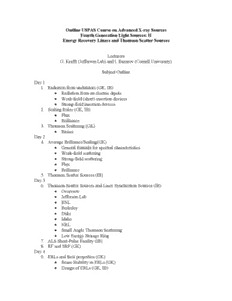
USPAS - Advanced X-Ray Sources [lecture slides] PDF
Preview USPAS - Advanced X-Ray Sources [lecture slides]
Outline USPAS Course on Advanced X-ray Sources Fourth Generation Light Sources: II Energy Recovery Linacs and Thomson Scatter Sources Lecturers G. Krafft (Jefferson Lab) and I. Bazarov (Cornell University) Subject Outline Day 1 1. Radiation from undulators (GK, IB) • Radiation from an electric dipole • Weak-field (short) insertion devices • Strong-field insertion devices 2. Scaling Rules (GK, IB) • Flux • Brilliance 3. Thomson Scattering (GK) • Basics Day 2 4. Average Brilliance/Scaling(GK) • General formula for spectral characteristics • Weak-field scattering • Strong-field scattering • Flux • Brilliance 5. Thomson Scatter Sources (IB) Day 3 6. Thomson Scatter Sources and Laser Synchrotron Sources (IB) • Overview • Jefferson Lab • BNL • Berkeley • Duke • Idaho • NRL • Small Angle Thomson Scattering • Low Energy Storage Ring 7. ALS Short-Pulse Facility (IB) 8. RF and SRF (GK) Day 4 9. ERLs and their properties (GK) • Beam Stability in ERLs (GK) • Design of ERLs (GK, IB) 10. ERL example (JLAB IRFEL) (GK) 11. ERL example (Cornell prototype and Phase II design) (IB) Day 5 12. ERL examples (BNL, Berkeley, Japan, Erlangen, MARS, 4GLS) (IB) 13. Critical Future Problems to be solved (IB) Lectures will be 9:00-12:00 am, and 1:30-3:00 pm on Monday through Thursday. Homework will be assigned every evening to be turned in the morning. There will generally be 3-5 problems, one or two Jackson-level derivations and several other problems that will be more like: filling in derivation steps or evaluating formulas in particular cases. Please bring along a calculator. We have not been able to set up any computer-lab demonstrations. Just the same, on completing the course you will have a thorough understanding of completing standard source parameter calculations. Two previous USPAS documents will be distributed to you on arrival. “Characteristics of Synchrotron Radiation” by Kwang-Je Kim and Part I of Sam Krinsky’s 1999 Lecture series on High Gain FELs. CCHHEESSSS // LLEEPPPP USPAS Course on 4th Generation Light Sources II ERLs and Thomson Scattering G. A. Krafft and I. V. Bazarov Jefferson Lab and Cornell University Introduction to Undulator Radiation USPAS 4thGeneration Light Sources II Krafft/Bazarov 13 January 2003 Thomas Jefferson National Accelerator Facility Prerequisites CCHHEESSSS // LLEEPPPP . Jackson (Classical Electrodynamics) or Landau and Lifshitz (The Classical Theory of Fields) level of understanding of electrodynamics . Facility in arguments based on the Special Theory of Relativity . Some previous exposure to particle accelerators, and typical single particle motion calculations for relativistic particle motion . Understanding of statistical arguments at the level of a typical undergraduate course in Thermodynamics or Statistical Mechanics USPAS 4thGeneration Light Sources II Krafft/Bazarov 13 January 2003 Thomas Jefferson National Accelerator Facility Course Outline CCHHEESSSS // LLEEPPPP Day 1 1. Radiation from undulators (GK, IB) • Radiation from an electric dipole • Weak-field (short) insertion devices • Strong-field insertion devices 2. Scaling Rules (GK, IB) • Flux • Brilliance 3. Thomson Scattering (GK) • Basics USPAS 4thGeneration Light Sources II Krafft/Bazarov 13 January 2003 Thomas Jefferson National Accelerator Facility Course Outline CCHHEESSSS // LLEEPPPP Day 2 4. Average Brilliance/Scaling (GK) • General formula for spectral characteristics • Weak-field scattering • Strong-field scattering • Flux • Brilliance 5. Thomson Scatter Sources (IB) USPAS 4thGeneration Light Sources II Krafft/Bazarov 13 January 2003 Thomas Jefferson National Accelerator Facility Course Outline CCHHEESSSS // LLEEPPPP Day 3 6. Thomson Scatter Sources and Laser Synchrotron Sources (IB) • Overview • Jefferson Lab • BNL • Berkeley • Duke • Idaho • NRL • Small Angle Thomson Scattering • Low Energy Storage Ring 7. ALS Short-Pulse Facility (IB) 8. RF and SRF (GK) USPAS 4thGeneration Light Sources II Krafft/Bazarov 13 January 2003 Thomas Jefferson National Accelerator Facility Course Outline CCHHEESSSS // LLEEPPPP Day 4 9. Energy Recovering Linacs (ERLs) and their properties (GK) • Beam Stability in ERLs (GK) • Design of ERLs (GK, IB) 10.ERL example (JLAB IRFEL) (GK) 11.ERL example (Cornell prototype and Phase II design) (IB) Day 5 12.ERL examples (BNL, Berkeley, Japan, Erlangen, MARS, 4GLS) (IB) 13.Critical Future Problems to be solved (IB) USPAS 4thGeneration Light Sources II Krafft/Bazarov 13 January 2003 Thomas Jefferson National Accelerator Facility Introductory Lecture: Undulators CCHHEESSSS // LLEEPPPP 1. Larmor Dipole Radiation 1. Review of Maxwell 2. Monochromatic “Dipole” Solution 3. Finite Pulse Solution 2. Lorentz Transformation 1. Photon Number Invariance 2. Wave Vector Transformation 3. Angular Distribution Transformation 3. Undulators 1. Parameters and Properties 2. General Solution for Small K 3. Finite K Effects 4. Qualitative Discussion on Angular Patterns 5. Finite Emittance Effects 6. Brilliance Scaling 7. Summary and Some Slides on Coherence USPAS 4thGeneration Light Sources II Krafft/Bazarov 13 January 2003 Thomas Jefferson National Accelerator Facility Media Free Maxwell Equations (cgs) r CCHHEESSSS // LLEEPPPP ∇ ⋅ E = 4 πρ r ∇ ⋅ B = 0 r r 1 ∂ B ∇ × E = − c ∂ t r r 4 π r 1 ∂ E ∇ × B = J + c c ∂ t c Have wave solutions with wave velocity USPAS 4thGeneration Light Sources II Krafft/Bazarov 13 January 2003 Thomas Jefferson National Accelerator Facility
